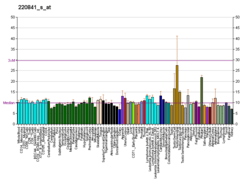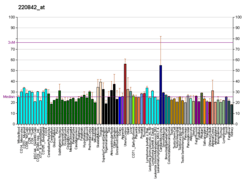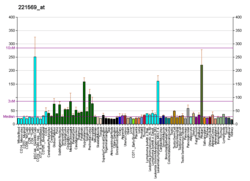AHI1
The Abelson helper integration site 1 (AHI1) is a protein coding gene that is known for the critical role it plays in brain development.[1] Proper cerebellar and cortical development in the human brain depends heavily on AHI1. The AHI1 gene is prominently expressed in the embryonic hindbrain and forebrain.[1] AHI1 specifically encodes the Jouberin protein and mutations in the expression of the gene is known to cause specific forms of Joubert syndrome. Joubert syndrome is autosomal recessive and is characterized by the brain malformations and mental retardation that AHI1 mutations have the potential to induce.[2] AHI1 has also been associated with schizophrenia and autism due to the role it plays in brain development.[3] An AHI1 heterozygous knockout mouse model was created to study the correlation between alterations in AHI1 expression and the pathogenesis of neuropsychiatric disorders. The core temperatures and corticosterone secretions of the heterozygous knockout mice after exposure to environmental and visceral stress exhibited extreme repression of autonomic nervous system and hypothalamic-pituitary-adrenal responses. The knockout mice demonstrated an increased resilience to different types of stress and these results lead to a correlation between emotional regulation and neuropsychiatric disorders.[3]
Jouberin is a protein that in humans is encoded by the AHI1 gene.[8][9][10]
References
- 1 2 Dixon-Salazar, Tracy; Silhavy, Jennifer L.; Marsh, Sarah E.; Louie, Carrie M.; Scott, Lesley C.; Gururaj, Aithala; Al-Gazali, Lihadh; Al-Tawari, Asma A.; Kayserili, Hulya (2004-12-01). "Mutations in the AHI1 Gene, Encoding Jouberin, Cause Joubert Syndrome with Cortical Polymicrogyria". American Journal of Human Genetics. 75 (6): 979–987. doi:10.1086/425985. ISSN 0002-9297. PMC 1182159. PMID 15467982.
- ↑ Amann-Zalcenstein, Daniela; Avidan, Nili; Kanyas, Kyra; Ebstein, Richard P.; Kohn, Yoav; Hamdan, Adnan; Ben-Asher, Edna; Karni, Osnat; Mujaheed, Muhammed (2006-06-14). "AHI1, a pivotal neurodevelopmental gene, and C6orf217 are associated with susceptibility to schizophrenia". European Journal of Human Genetics. 14 (10): 1111–1119. doi:10.1038/sj.ejhg.5201675. ISSN 1018-4813. PMID 16773125.
- 1 2 Lotan, A; Lifschytz, T; Slonimsky, A; Broner, E C; Greenbaum, L; Abedat, S; Fellig, Y; Cohen, H; Lory, O. "Neural mechanisms underlying stress resilience in Ahi1 knockout mice: relevance to neuropsychiatric disorders". Molecular Psychiatry. 19 (2): 243–252. doi:10.1038/mp.2013.123. PMID 24042478.
- 1 2 3 GRCh38: Ensembl release 89: ENSG00000135541 - Ensembl, May 2017
- 1 2 3 GRCm38: Ensembl release 89: ENSMUSG00000019986 - Ensembl, May 2017
- ↑ "Human PubMed Reference:".
- ↑ "Mouse PubMed Reference:".
- ↑ Lagier-Tourenne C, Boltshauser E, Breivik N, Gribaa M, Betard C, Barbot C, Koenig M (Apr 2004). "Homozygosity mapping of a third Joubert syndrome locus to 6q23". J Med Genet. 41 (4): 273–7. doi:10.1136/jmg.2003.014787. PMC 1735723. PMID 15060101.
- ↑ Utsch B, Sayer JA, Attanasio M, Pereira RR, Eccles M, Hennies HC, Otto EA, Hildebrandt F (Mar 2006). "Identification of the first AHI1 gene mutations in nephronophthisis-associated Joubert syndrome". Pediatr Nephrol. 21 (1): 32–5. doi:10.1007/s00467-005-2054-y. PMID 16240161.
- ↑ "Entrez Gene: AHI1 Abelson helper integration site 1".
External links
- Human AHI1 genome location and AHI1 gene details page in the UCSC Genome Browser.
Further reading
- Maruyama K, Sugano S (1994). "Oligo-capping: a simple method to replace the cap structure of eukaryotic mRNAs with oligoribonucleotides". Gene. 138 (1–2): 171–4. doi:10.1016/0378-1119(94)90802-8. PMID 8125298.
- Suzuki Y, Yoshitomo-Nakagawa K, Maruyama K, et al. (1997). "Construction and characterization of a full length-enriched and a 5'-end-enriched cDNA library". Gene. 200 (1–2): 149–56. doi:10.1016/S0378-1119(97)00411-3. PMID 9373149.
- Hartley JL, Temple GF, Brasch MA (2001). "DNA Cloning Using In Vitro Site-Specific Recombination". Genome Res. 10 (11): 1788–95. doi:10.1101/gr.143000. PMC 310948. PMID 11076863.
- Wiemann S, Weil B, Wellenreuther R, et al. (2001). "Toward a Catalog of Human Genes and Proteins: Sequencing and Analysis of 500 Novel Complete Protein Coding Human cDNAs". Genome Res. 11 (3): 422–35. doi:10.1101/gr.GR1547R. PMC 311072. PMID 11230166.
- Jiang X, Hanna Z, Kaouass M, et al. (2002). "Ahi-1, a Novel Gene Encoding a Modular Protein with WD40-Repeat and SH3 Domains, Is Targeted by the Ahi-1 and Mis-2 Provirus Integrations". J. Virol. 76 (18): 9046–59. doi:10.1128/JVI.76.18.9046-9059.2002. PMC 136442. PMID 12186888.
- Strausberg RL, Feingold EA, Grouse LH, et al. (2003). "Generation and initial analysis of more than 15,000 full-length human and mouse cDNA sequences". Proc. Natl. Acad. Sci. U.S.A. 99 (26): 16899–903. doi:10.1073/pnas.242603899. PMC 139241. PMID 12477932.
- Mungall AJ, Palmer SA, Sims SK, et al. (2003). "The DNA sequence and analysis of human chromosome 6". Nature. 425 (6960): 805–11. doi:10.1038/nature02055. PMID 14574404.
- Ota T, Suzuki Y, Nishikawa T, et al. (2004). "Complete sequencing and characterization of 21,243 full-length human cDNAs". Nat. Genet. 36 (1): 40–5. doi:10.1038/ng1285. PMID 14702039.
- Jiang X, Zhao Y, Chan WY, et al. (2004). "Deregulated expression in Ph+ human leukemias of AHI-1, a gene activated by insertional mutagenesis in mouse models of leukemia". Blood. 103 (10): 3897–904. doi:10.1182/blood-2003-11-4026. PMID 14751929.
- Close J, Game L, Clark B, et al. (2004). "Genome annotation of a 1.5 Mb region of human chromosome 6q23 encompassing a quantitative trait locus for fetal hemoglobin expression in adults". BMC Genomics. 5: 33. doi:10.1186/1471-2164-5-33. PMC 441375. PMID 15169551.
- Ferland RJ, Eyaid W, Collura RV, et al. (2004). "Abnormal cerebellar development and axonal decussation due to mutations in AHI1 in Joubert syndrome". Nat. Genet. 36 (9): 1008–13. doi:10.1038/ng1419. PMID 15322546.
- Dixon-Salazar T, Silhavy JL, Marsh SE, et al. (2005). "Mutations in the AHI1 Gene, Encoding Jouberin, Cause Joubert Syndrome with Cortical Polymicrogyria". Am. J. Hum. Genet. 75 (6): 979–87. doi:10.1086/425985. PMC 1182159. PMID 15467982.
- Gerhard DS, Wagner L, Feingold EA, et al. (2004). "The Status, Quality, and Expansion of the NIH Full-Length cDNA Project: The Mammalian Gene Collection (MGC)". Genome Res. 14 (10B): 2121–7. doi:10.1101/gr.2596504. PMC 528928. PMID 15489334.
- Wiemann S, Arlt D, Huber W, et al. (2004). "From ORFeome to Biology: A Functional Genomics Pipeline". Genome Res. 14 (10B): 2136–44. doi:10.1101/gr.2576704. PMC 528930. PMID 15489336.
- Parisi MA, Doherty D, Eckert ML, et al. (2006). "AHI1 mutations cause both retinal dystrophy and renal cystic disease in Joubert syndrome". J. Med. Genet. 43 (4): 334–9. doi:10.1136/jmg.2005.036608. PMC 2563230. PMID 16155189.
- Mehrle A, Rosenfelder H, Schupp I, et al. (2006). "The LIFEdb database in 2006". Nucleic Acids Res. 34 (Database issue): D415–8. doi:10.1093/nar/gkj139. PMC 1347501. PMID 16381901.
- Valente EM, Brancati F, Silhavy JL, et al. (2006). "AHI1 gene mutations cause specific forms of Joubert syndrome-related disorders". Ann. Neurol. 59 (3): 527–34. doi:10.1002/ana.20749. PMID 16453322.
- Amann-Zalcenstein D, Avidan N, Kanyas K, et al. (2006). "AHI1, a pivotal neurodevelopmental gene, and C6orf217 are associated with susceptibility to schizophrenia". Eur. J. Hum. Genet. 14 (10): 1111–9. doi:10.1038/sj.ejhg.5201675. PMID 16773125.






